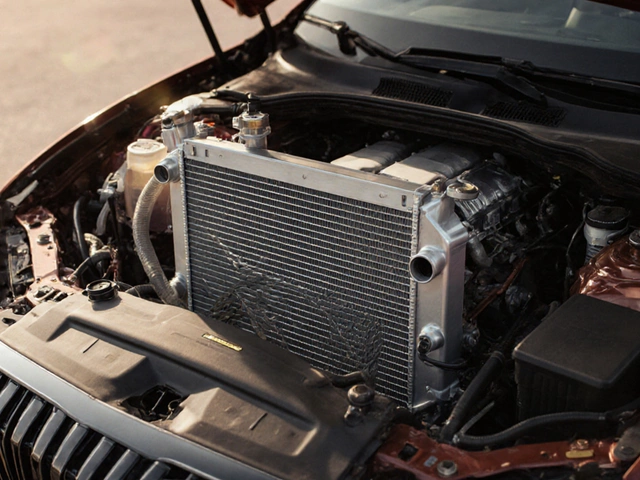
Ever heard someone say, "Just use regular oil, it’s cheaper!" and felt tempted? You’re not alone. The price gap between regular and synthetic oil can make people question if it’s worth the splurge. But what really happens when you pour regular oil into an engine that’s been sipping synthetic? It turns out, the difference isn’t just marketing or color—it’s about everything from engine life to how your car starts on a freezing morning. Let's hit the nuts and bolts of regular oil vs. synthetic before you shake that next quart loose at the shop.
Understanding Regular Oil and Synthetic Oil
Let's get clear on what we're pouring in the engine. Regular oil—more accurately called "conventional oil"—comes straight from crude, with just enough refining to be safe for engine parts. Synthetic oil, on the other hand, is made by tinkering with the base molecules to make them more uniform, more slippery, and better at standing up to heat and cold. Imagine regular oil like orange juice with pulp; synthetic is the filtered, no-bits-y version.
The difference isn’t just in origin. Synthetics have additives and boosters that help them resist breakdown, sludge, and even burning off at high temps. That’s why most modern cars, especially turbocharged engines or those suffering rush hour idling, call for synthetic. According to a 2023 report by the American Automobile Association, synthetic oils outperformed conventional oils by 47% in standardized engine tests, meaning they kept things cleaner and running smoother over time.
But, some engines designed before this synthetic craze hit (think mid-90s or earlier) can still run just fine on regular oil—at least on paper. Car makers didn’t always push for synthetic, simply because engines weren’t built for the higher performance we expect (and need) now. Fun fact: a 2021 survey by CarTalk found that 79% of drivers didn’t know whether their car required synthetic oil or not, often mixing them up at quick-lube chains.
So, if you’re about to top up, check your owner’s manual. That book in the glovebox is there for a reason, and it usually spells out exactly what your engine was built to take. If it calls for synthetic and you use regular, you’re not just ignoring advice—you might end up paying for it later.
The Science Behind Why Your Oil Choice Matters
So, your friend’s old Civic has 220,000 miles and still runs on regular oil? Sure, but here’s why that story doesn’t always translate. Internal combustion generates a brutal cocktail of heat, pressure, and dirty by-products. Regular oil starts to thicken or "sludge" after a few thousand miles, especially if you do a lot of city driving or your neighborhood feels like an oven in July. That gooey sludge? It’s like plaque in your arteries, starving your engine of lubrication until things start grinding down one unhappy bearing at a time.
Synthetic oils don’t sludge up nearly as fast—they’re engineered to handle punishing cycles of hot and cold. In fact, their molecules are designed to stay slick and keep cleaning everything in sight. Compare it to athletes drinking specialized sports drinks versus just water. It’s not vital for everyone, but it makes a difference when moving at top speed.
Oil breakdown is another enemy. When regular oil gets too hot, its protective film gets thinner, and pretty soon, metal starts wearing metal. According to data from Mobil 1 (yep, those guys testing oil in actual engines for decades), synthetic oil maintains stable viscosity at temperatures regular oil would cry uncle. Your turbocharged engine? That extra sizzle can cook regular oil in just a few days if you’re unlucky.
But temperature extremes aren’t the only concern. Cold starts—when oil is thick like maple syrup—are hardest on engines. Synthetic oil flows instantly, even at temps below freezing, while regular oil can take up to double the time to circulate. That delay means extra wear on pistons and cams every single morning. Imagine skipping breakfast and then running a marathon—eventually, it catches up with you.

What Actually Happens If You Use Regular Oil Instead of Synthetic?
Let’s get to the ugly part. If your car is built for synthetic oil but you pour in regular oil instead, here’s what actually goes down:
- Increased Engine Wear: Metal rubs against metal more easily when the oil film breaks down. Long-term, this means more frequent repairs, annoying engine knocks, or even total engine failure if neglected.
- Shorter Oil Life: Regular oil needs changing way more often. You’ll burn through oil changes about twice as fast if your engine runs hot or does lots of short trips.
- Sludge Formation: Remember that sludge we talked about? Regular oil forms it quicker. That means sticky build-up in spots where your engine needs free-flowing oil the most.
- Poor Performance in Extremes: Expect slower cold starts in winter. In summer, or if you’re towing, heat will thin regular oil so much it’ll lose its protective qualities—and that wear adds up.
- Reduced Fuel Economy: Worn engines and thicker oil both sap efficiency. That extra $15 you saved per oil change? You’ll probably burn it (and more) in lower miles per gallon.
- Voided Warranty: If your car is under warranty and it says "use synthetic only," switching to regular can void engine coverage. That’s one headache you don’t want.
Want to see the difference in data? Check out this simple table, comparing regular and synthetic oil:
| Regular Oil (Conventional) | Synthetic Oil | |
|---|---|---|
| Oil Change Interval | 3,000-5,000 miles | 7,500-15,000 miles |
| Breakdown at High Temps | High | Low |
| Cold Flow Ability | Moderate | Excellent |
| Sludge Build Up | Likely | Minimal |
| Cleans Engine | Somewhat | Yes |
| Typical Cost/Quart | $5-$7 | $9-$12 |
So yeah, regular oil looks cheaper on the sticker, but it starts to nibble away at your wallet if you’re keeping the car long-term or actually follow the manual. My neighbor’s brother-in-law tried to stretch oil changes to 7,500 miles with regular, and he ended up paying double for engine cleaning at year’s end.
When Is It (Maybe) Okay to Use Regular Oil?
Not every car needs the red carpet treatment. If you’re piloting a twenty-year-old Corolla that’s never seen synthetic in its life, and you drive easy miles far from traffic jams, regular oil could -- just maybe -- be enough. Some older engines even seal better with regular oil, which is a bit thicker and can fill up gaps from wear. But most of these engines have higher tolerances (meaning their parts aren’t squeezed together as tightly as new engines), so oil doesn’t have to be molecularly perfect to do its job.
Classic cars, farm trucks, and some motorcycles ran perfectly fine on regular oil for decades. The catch? They also got their oil changed all the time—back then, 3,000 miles was gospel, and sludge was expected. Compare that to modern cars, where manufacturers expect oil to last up to 15,000 miles (that’s half a year or more for most people) before you even think about a change.
Even then, switching to synthetic in an old car usually isn't a problem anymore. That myth about seals "leaking out" when you switch got debunked ages ago, as better manufacturing and better additives fixed the issue. Unless you spot blue smoke pouring out the tailpipe or oil drops forming under your car after a switch, synthetic is safe in nearly any engine that’s not already on its last legs.
But seriously, if you drive a turbo, have direct injection, or see "synthetic oil required" anywhere in your owner's manual, just don’t risk it. Car companies know how fast engines run hotter and more precisely now. Going cheap on oil in these engines is like putting off a dentist appointment—you’ll pay much more down the road.

Practical Tips for Choosing and Swapping Engine Oil
If you’ve ever stood in an auto parts store, holding two jugs of oil and wondering what’s really at stake, here are some tips from years of trial and error (and a few too many late-night oil changes in my driveway):
- Always Check the Manual: That little book knows things even your mechanic doesn’t. If it says synthetic, don’t fudge it. Manufacturers test for years before making those calls—trust the data.
- Don’t Mix and Match Long-Term: While topping off with regular oil once in an emergency won’t doom your engine, doing it every oil change eventually breaks down the protection. If you have to mix oils, get your next change done soon and swap in the right stuff.
- Stick to a Schedule: Synthetic gives you longer change intervals, but don’t stretch it beyond what the manual says. Old oil, regardless of type, collects moisture, dirt, and fuel that can wear out your engine way before its time.
- Check Your Driving Habits: If you do short trips or lots of stop-and-go, your oil degrades faster. Engineered or not, city life is tough on oil. Plan your changes accordingly.
- Keep Your Receipts: If your car is under warranty, proof of what oil you used and when could save you thousands if something goes sideways. Phone photos or a folder in the glovebox work wonders.
- Cost vs Value: Don’t just look at what you pay at the counter. Think about potential repairs, fuel savings, and longer intervals. Synthetic can pay for itself over time, especially in engines with tight tolerances.
Here’s another fun tip: Me and Amelia got into the habit of scheduling oil changes with tire rotations. Two birds, one appointment. Especially when we’re about to take a road trip. It's a simple system and keeps us from forgetting, which happens way too often if I leave it to memory.
If you’re curious about oil specifics—like what brands score best—Consumer Reports has an annual test of oils in real, high-mileage engines. In 2024, Pennzoil Platinum got high marks for both longevity and keeping engines clean, especially in turbocharged models popular in today’s crossovers.
And for those rare times you need a quick fix: Synthetic blends (a mix of regular and synthetic) are out there, and might suit older engines if budget’s tight. They won’t match pure synthetic in every area, but offer better protection than straight conventional. Just don’t see them as a magic compromise—read your manual first!





